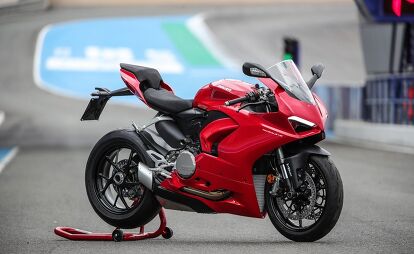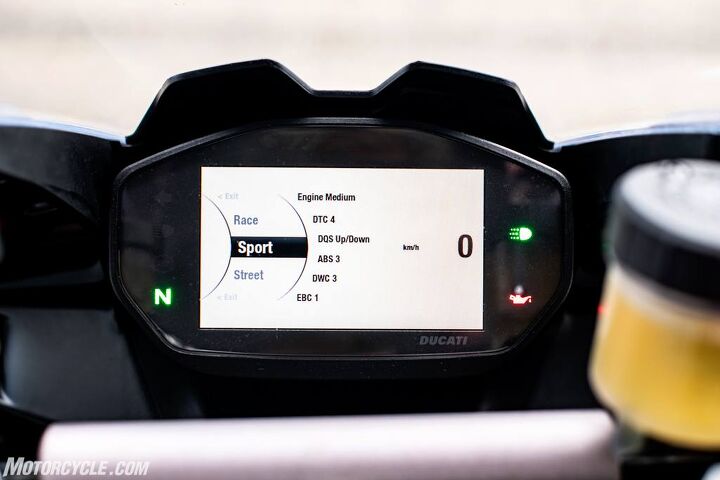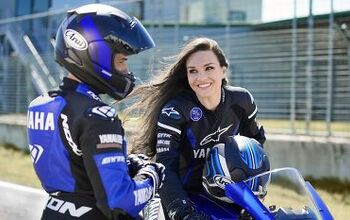5 Things You Need To Know About The Ducati Panigale V2

The highs and lows of Ducati's Super-Mid
The phrase “Super-Mid” is about as meaningless as they come in motorcycling, but nonetheless, Ducati has used it to label its smaller displacement sportbike; in this case the Panigale V2. Essentially the previous Panigale 959 with a facelift and V4-level electronics, this odd-displacement sportbike not only has a weird engine size – 955cc – but it’s a V-Twin to boot (and no need to “correct” me about not calling it an L-Twin, because even Ducati calls it a V2 now), putting it in a distinguished field of outliers in the sportbike class, joining the Suzuki GSX-R750, Kawasaki ZX-6R and its 636cc engine, and the now-discontinued Triumph Daytona 675. We’re not counting the Triumph Street Triple 765 since it’s not really a sportbike.
Without question, the Panigale V2 is the most advanced bike in this class, and after riding it at its press launch at the Jerez circuit in Spain, I came back with a smile over just how fun a motorcycle it is to ride. We’ve recently had a chance to get our hands on one on home soil, and after putting a couple miles on it both on the street and the track, here are five things you need to know about the Ducati Panigale V2.
Looks good
I know beauty is in the eye of the beholder, but does this bike not look good? The slight facelift to align it more with its V4 sibling was a step in the right direction. Even better, at least for Europeans who might be reading this, the V2 exhaust is Euro5 compliant, meaning you don’t need to stick on two giant cans to the end of the exhaust like you did with the previous 959 to meet regulations. Not only is the new nose section more attractive, the intake funnels are much freer-flowing than before. The V2 also gets a single-sided swingarm for a little extra pizazz!
Electronics
In this day and age, if your sportbike doesn’t have an IMU, is it even a sportbike? Apparently, Ducati looked at the previous Panigale 959 and thought the same thing. With the V2, you get the same electronics package as the big-boy Panigale V4, based around a Bosch 6-axis IMU. With that, you get the Ducati Traction Control, Cornering ABS, and Wheelie Control. Not to mention a quickshift up/down feature, and Engine Brake Control.
HOT
Like seemingly every recent Ducati sportbike of the past decade, the Panigale V2 runs hot. Like, really hot. Not surprising considering the rear cylinder’s exhaust routing is right under your butt. This isn’t so bad when you’re on a racetrack and have plenty of airflow going around, but on the street, the heat is simply brutal. It’s not until you’re going at speeds well north of the legal limits before you get enough air to move the heat away. So, road rides become a measure of how pink you want the insides of your leg to be. Medium rare, anyone?
Easy to ride
If there’s a word to describe the Panigale V2, it’s balanced. The 955cc V-Twin makes enough power to have a good time but doesn’t scare the daylights out of you, and the chassis is matched well to that amount of power. Put it together, and you have a motorcycle that’s a blast on a racetrack and equally enjoyable on a canyon road (heat aside). It won’t set any track records, but it’s not like anyone looking to do that would pick this bike, anyway. The Panigale V2 is the choice for the discerning sportbike rider with nothing to prove.
At $16,500, what does it get you?
Then again, at $16,500, the Panigale V2 is right in line with several Japanese and Italian sportbikes with proper 1000cc engines, similar electronics, and comparable suspension. What do you do then? The answer always goes back to: What do you want in a motorcycle? If the Ducati ownership experience is something you want, and the V2 offers the kind of performance you’re looking for, it’s not a bad choice. Then again, if it’s bang-for-the-buck you seek, there are better options out there.

Troy's been riding motorcycles and writing about them since 2006, getting his start at Rider Magazine. From there, he moved to Sport Rider Magazine before finally landing at Motorcycle.com in 2011. A lifelong gearhead who didn't fully immerse himself in motorcycles until his teenage years, Troy's interests have always been in technology, performance, and going fast. Naturally, racing was the perfect avenue to combine all three. Troy has been racing nearly as long as he's been riding and has competed at the AMA national level. He's also won multiple club races throughout the country, culminating in a Utah Sport Bike Association championship in 2011. He has been invited as a guest instructor for the Yamaha Champions Riding School, and when he's not out riding, he's either wrenching on bikes or watching MotoGP.
More by Troy Siahaan







































Comments
Join the conversation
I’m poor... Like, REAL poor! I’m also a former track-day hack, (1989, Hockenheimring while stationed in Stuttgart in the Army), and just-retired amateur flat tracker. So after researching, I discovered the only way to get my hands on a Bike with the Bosch IMU and be able to afford to regularly flog the crap out of it on the track without being bankrupted by maintenance or emotionally shattered by the occasional get-off, (overcooked corner entries are my spiritual gift), was to scoop up a KTM 790 Duke. So I’ll just have to keep adoring those gorgeous Panigales from afar. But laying down fat blackies off the corners at Spokane County Raceway a few times every summer without having to skip 2 mortgage payments is a pretty survivable consolation prize. Thanks, KTM!
My 2001 Triumph Sprint ST thinks 955 is just the right size!
After 20 years, can't disagree.